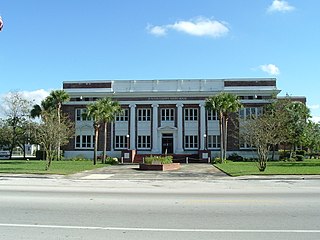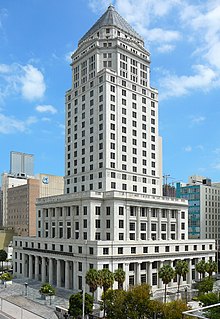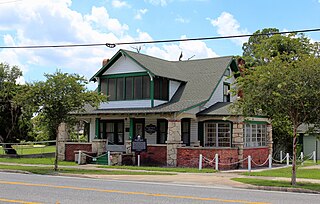
Flagler County is a county located on the northeastern coast of the U.S. state of Florida. As of the 2010 census, the population was 95,696. Its county seat is Bunnell. Created in 1917 from portions of Saint Johns and Volusia Counties, it was named for Henry Morrison Flagler, who built the Florida East Coast Railway.

Bunnell is the county seat of Flagler County Florida, United States, with a population of 2,676 at the 2010 census. The city is part of the Deltona–Daytona Beach–Ormond Beach, FL metropolitan statistical area and is named after an early resident, Alvah A. Bunnell, a shingle maker and supplier of wood to the area's fledgling rail industry.

There are more than 1,800 properties and districts listed on the National Register of Historic Places in Florida. They are distributed through 66 of the state's 67 counties. Of these, 42 are National Historic Landmarks.

Bulow Plantation Ruins Historic State Park is a Florida State Park in Flagler Beach, Florida. It is three miles west of Flagler Beach on CR 2001, south of SR 100, and contains the ruins of an ante-bellum plantation and its sugar mill, built of coquina, a fossiliferous sedimentary rock composed of shells. It was the largest plantation in East Florida, and was operated with the forced labor of enslaved Africans and African Americans.
State Road 13 (SR 13) is a 28.25-mile-long (45.46 km) state highway in the U.S. state of Florida, running north from SR 16 near Green Cove Springs, through Switzerland to Jacksonville on the east shore of the St. Johns River.

The Downtown Miami Historic District is a U.S. historic district located in the CBD of Downtown Miami, Florida. The district is bounded by Miami Court, North Third Street, West Third Avenue, and South Second Street. It contains 60 historic buildings. A large portion the buildings in the historic district were built during the Florida land boom of the 1920s, when Miami experienced rapid population growth. Many of the older structures from before the 1920s, were smaller scale buildings and homes from the Miami pioneer era of the mid and late-19th century. Palm Cottage, built in 1897 is a home from the pioneer era that is still standing, however, few of these original homes remain.

The Mala Compra Plantation Archeological Site is an archaeological site in Palm Coast, Florida, on the east bank of the Matanzas River. It is located west of the intersection of State Road A1A and Mala Compra Drive at Bings Landing County Park in Flagler County. On March 5, 2004, it was added to the United States National Register of Historic Places.

The Miami-Dade County Courthouse, formerly known as the Dade County Courthouse, is a historic courthouse located at 73 West Flagler Street in Miami, Florida. Constructed over four years (1925–28), it was added to the U.S. National Register of Historic Places on January 4, 1989. The building is 361 feet tall with 28 floors. When it was built, it was the tallest building in Miami and in Florida.

The Lummus Park Historic District or simply Lummus Park, is on the National Register of Historic Places and a locally historic designated district in Miami, Florida. It is roughly bound by Northwest Fifth Street to the north, Flagler Street to the south, Northwest Third Avenue to the east, and the Miami River to the west. On October 25, 2006, it was added to the U.S. National Register of Historic Places. Lummus Park has some of the oldest structures in Miami, and over the decades, has been able to retain a large part of its early pioneer character.

The Vocational Agriculture Building was built by the Works Projects Administration (WPA) in 1938 with funding from the Flagler County Board of Public Instruction and the WPA. It is located at 1001 E. Howe St., Bunnell, Florida, United States. Interestingly, it never served as a schoolhouse as it was used as Bunnell High School's vocational agriculture department and housed the local chapter of the Future Farmers of America, which is now known as the National FFA Organization. The building is also often mistaken for a one-room schoolhouse, but it actually has two large rooms and a smaller storage room. This building is one of only three structures built in Flagler County during the Great Depression with funding provided by New Deal dollars. The other two are the Bunnell Coquina City Hall and the Flagler County Jail (WPA-Built).

The Old Flagler County Courthouse is an historic two-story redbrick courthouse building located at 200 East Moody Boulevard in Bunnell, Florida. Designed by Wilbur Talley in the Classical Revival style, it was built in 1924 by O. P. Woodcock to serve Flagler County which had been created in 1917. It was the county's second courthouse building and its first purpose built one. In 1985 a three-story addition was attached to its rear. In January 2007 the 1924 building was closed due to safety problems with its roof. By January 2008, the 1985 addition had also been vacated due to structural problems. Courthouse operations are now housed at the Kim C. Hammond Justice Center 1769 East Moody Boulevard.

This is a list of the National Register of Historic Places listings in Flagler County, Florida.
Harvey and Clarke was an American architectural firm formed by Henry Stephen Harvey and L. Philips Clarke in West Palm Beach, Florida, in 1921. The firm was active in South Florida for only a few years, but in that time designed a number of distinctive homes, apartments, churches, and commercial buildings. Harvey was a member of the West Palm Beach Planning Commission. Firm member Gustav Maass designed several railroad stations, and became a noted South Florida architect in his own right.

Wilbur B. Talley was an architect in Florida. He worked in Jacksonville until the death of his wife Nellie and daughter Sarah, who were riding in a car hit by a train on December 21, 1919. After the accident, he moved to Lakeland, Florida where he continued working as an architect.

Isaac I. Moody Jr. was born in Appling County, Georgia and moved to St. Johns County, Florida in the early 1890s and first worked in the turpentine business as a woods rider near present-day Bunnell, Florida. He ventured into various businesses including turpentine, shingle milling, real estate and banking. After getting into politics he quickly gained influence and local and statewide respect and was instrumental in the establishment of Flagler County, Florida in 1917. He was a 32nd degree Mason, and was elected as Worshipful Master of the Bunnell Lodge No. 200 in 1918, and was a member of the Morocco Temple of Shriners at Jacksonville, FL. Today, he is remembered as the "Father of Flagler County."

The Holden House, located at 204 E. Moody Blvd., Bunnell, Florida, was built in 1918 by Samuel Merwin Bortree (1859-1918) as a wedding gift for his daughter Ethel Lura Bortree Holden (1892-1977), and her husband Thomas Edward Holden (1892-1974). It is an excellent example of the Craftsman Bungalow architectural style. The house was purchased by Flagler County for $40,000 on August 6, 1979 from a Holden family member. It is now a museum that features artifacts from Flagler County and the general Florida area dating from the St. Johns Culture to the present. It is also the headquarters for the Flagler County Historical Society. The house's upstairs bathroom was one of the first indoor bathrooms in the Bunnell area and features unique small hexagon tiles on the floor which were similar to the flooring design used in the original owner's pharmacy building which is no longer extant and was located at the southwest corner of the intersection of Moody Boulevard and U.S. 1 in Bunnell. The Holden House was listed on the National Register of Historic Places on October 16, 2018.

The Bunnell Coquina City Hall is a unique one-story public building constructed of locally quarried coquina stone. The property is located at 200 South Church Street, Bunnell, FL 32110 in the downtown section of the city. It includes man-made Lake Lucille with its jetting fountain in the front of the building, which creates an impressive visual appeal to the setting of the property. It was built in 1936–1937 with grant funding from the Work Progress Administration WPA.

Towering over the City of Bunnell is the city's most visible and iconic landmark: the City of Bunnell elevated steel water tower. The water tower is located at 100 Utility Street, Bunnell, FL 32110. It was built in 1926 by Chicago Bridge & Iron Company as part of a new waterworks system for Bunnell that went into operation in December 1927 and has been providing water to residents and local businesses to this day. The water tower is 110 feet high and its elevated steel tank holds 75,000 gallons of water. The elevated steel water tank has a conical top, Horton hemispherical bottom and is supported by four steel columns (legs) and reinforced with steel cross braces. The east and west sides of the elevated tank have black painted signage that read “City of Bunnell, Crossroads of Flagler County”

During the 1930s, the Flagler County, Florida Jail was in dire need of repairs and enlargement. Flagler County Commissioners were under pressure from local citizens and grand juries to repair the building or erect a new one. After months of negotiations, during 1938, between the Flagler County Board of Commissioners and the Works Progress Administration WPA an agreement to build a new Flagler County Jail building was approved. A WPA Project, No. 4242, was approved that cost approximately $24,000. It was agreed that the costs would be divided between Flagler County and the WPA. Construction of the new Flagler County Jail started January 25, 1939 under the management of Z. D. Holland, WPA Supervisor and well known local contractor. It was built on 2.04 acres of county-owned property located at 1600 Old Moody Blvd., Bunnell, FL.

The Espanola Schoolhouse is a one-story; one-room rural school building that has survived from the Jim Crow racial segregation-era. It is the last standing one-room schoolhouse in Flagler County. It is located at 98 Knox Jones Avenue, Bunnell, Florida 32110.






















